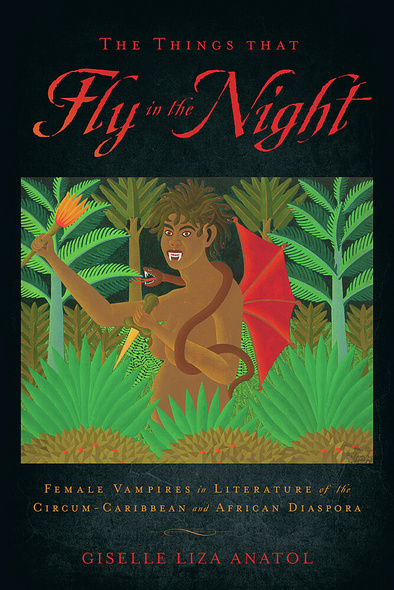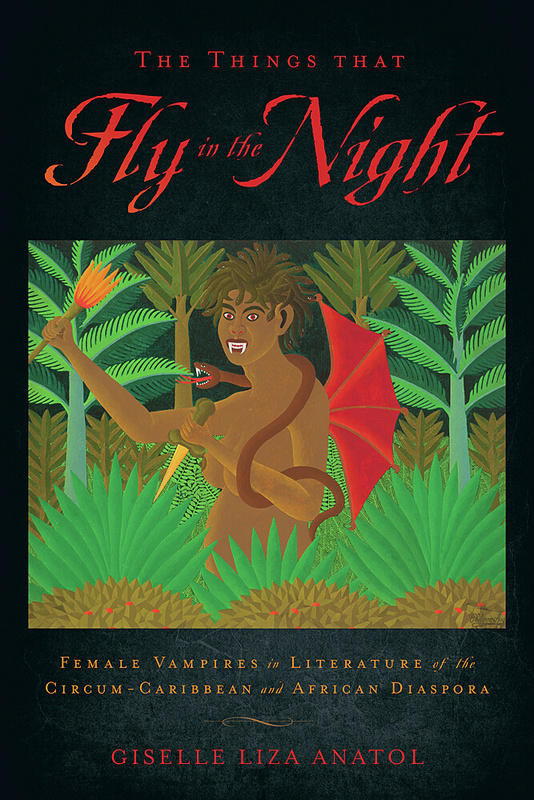The Things That Fly in the Night
Female Vampires in Literature of the Circum-Caribbean and African Diaspora
SERIES:
Critical Caribbean Studies
Rutgers University Press
The Things That Fly in the Night explores images of vampirism in Caribbean and African diasporic folk traditions and in contemporary fiction. Giselle Liza Anatol focuses on the figure of the soucouyant, or Old Hag—an aged woman by day who sheds her skin during night’s darkest hours in order to fly about her community and suck the blood of her unwitting victims. In contrast to the glitz, glamour, and seductiveness of conventional depictions of the European vampire, the soucouyant triggers unease about old age and female power. Tracing relevant folklore through the English- and French-speaking Caribbean, the U.S. Deep South, and parts of West Africa, Anatol shows how tales of the nocturnal female bloodsuckers not only entertain and encourage obedience in pre-adolescent listeners, but also work to instill particular values about women’s “proper” place and behaviors in society at large.
Alongside traditional legends, Anatol considers the explosion of soucouyant and other vampire narratives among writers of Caribbean and African heritage who in the past twenty years have rejected the demonic image of the character and used her instead to urge for female mobility, racial and cultural empowerment, and anti colonial resistance. Texts include work by authors as diverse as Nobel Laureate Toni Morrison, U.S. National Book Award winner Edwidge Danticat, and science fiction/fantasy writers Octavia Butler and Nalo Hopkinson.
This book is available as an audio book (https://www.abantuaudio.com/books/1197052/The-Things-That-Fly-in-the-Night).
This book is available as an audio book (https://www.abantuaudio.com/books/1197052/The-Things-That-Fly-in-the-Night).
The Things That Fly in the Night is an important book in the growing scholarship of Caribbean folklore and literature. Encyclopedic in its scope and grand in its theoretical ambition, Professor Anatol's study of the specters of Caribbean occult should be read by everyone interested in Afro-diasporic culture.
Anatol discusses contemporary literature that foregrounds the black female vampire as a figure through which to critique women’s prescribed roles in traditional folk legends, poetry, and songs of the African diaspora. In six well-organized, well-written chapters (framed by an introduction and a conclusion), the author provides an in-depth analysis of the tradition and its revisions.
In this brilliant, groundbreaking, and provocative study, Giselle Liza Anatol makes a major contribution to Diasporan folk culture and literature.
Things That Fly is indispensable for scholars interested in cultural studies, folklore, gender studies, and literary studies; it provides vital insight about the female vampire’s shifting roles in African Diasporan and circum-Caribbean literature and culture.
Anatol discusses contemporary literature that foregrounds the black female vampire as a figure through which to critique women’s prescribed roles in traditional folk legends, poetry, and songs of the African diaspora. In six well-organized, well-written chapters (framed by an introduction and a conclusion), the author provides an in-depth analysis of the tradition and its revisions.
Things That Fly is indispensable for scholars interested in cultural studies, folklore, gender studies, and literary studies; it provides vital insight about the female vampire’s shifting roles in African Diasporan and circum-Caribbean literature and culture.
The Things That Fly in the Night is an important book in the growing scholarship of Caribbean folklore and literature. Encyclopedic in its scope and grand in its theoretical ambition, Professor Anatol's study of the specters of Caribbean occult should be read by everyone interested in Afro-diasporic culture.
In this brilliant, groundbreaking, and provocative study, Giselle Liza Anatol makes a major contribution to Diasporan folk culture and literature.
GISELLE LIZA ANATOL is an associate professor of English at the University of Kansas at Lawrence.
Table of Contents
Chapter 1: Conventional Versions: The Soucouyant Story in Folktales, Fiction, and Calypso
Chapter 2: Nineteenth-Century Connections: European Vampire Stories and Configurations of the Demonic Black Woman
Chapter 3: Draining Life Rather Than Giving It: Maternal Legacies
Chapter 4: “Queering” the Norm: Vampirism and Women’s Sexuality
Chapter 5: Reconstructing a Nation of Strangers: Soucouyants in the Work of Tessa McWatt, David Chariandy, and Helen Oyeyemi
Chapter 6: Shedding Skin and Sucking Blood: Playing with Notions of Racial Intransigence















